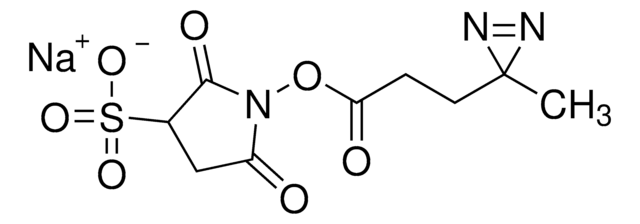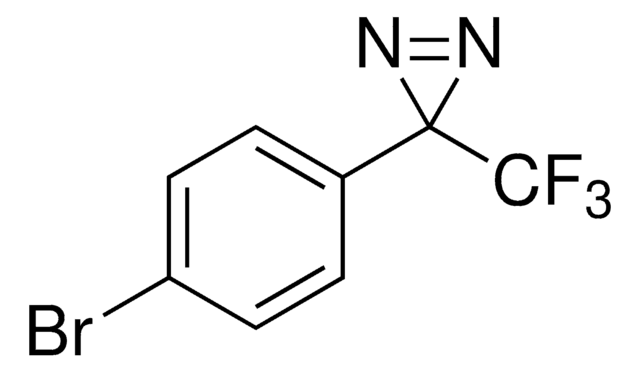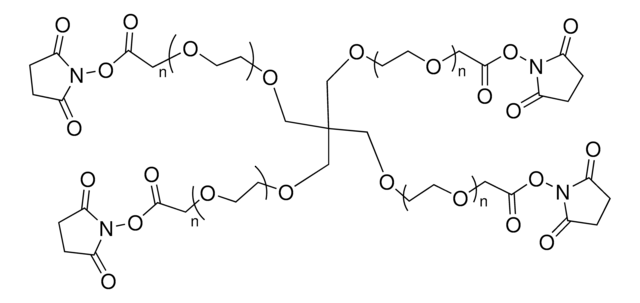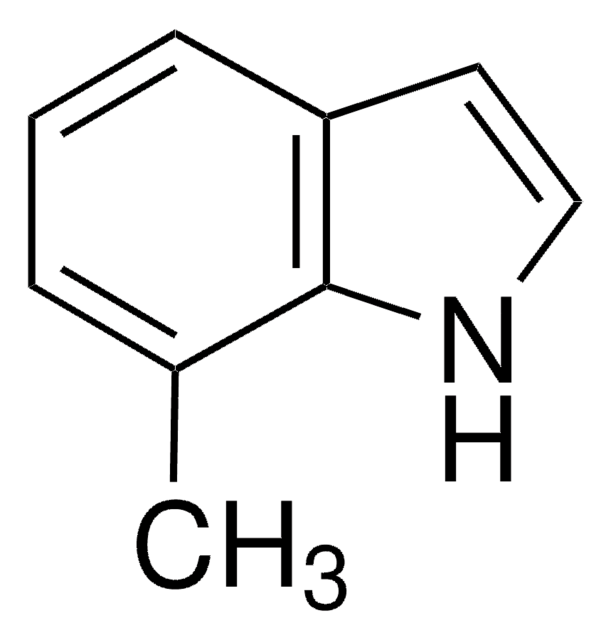803367
Sulfo-SDAD (Sulfo-NHS-SS-Diazirine) (sulfosuccinimidyl 2-[(4,4′-azipentanamido)ethyl]-1,3′-dithiopropionate]
About This Item
Productos recomendados
assay
≥80%
form
powder
mol wt
490.51
reaction suitability
reagent type: cross-linking reagent
storage condition
desiccated
solubility
water: soluble
shipped in
ambient
storage temp.
2-8°C
SMILES string
CC1(N=N1)CCC(NCCSSCCC(ON2C(C(S([O-])(=O)=O)CC2=O)=O)=O)=O.[Na+]
InChI
1S/C14H20N4O8S3.Na/c1-14(16-17-14)4-2-10(19)15-5-7-28-27-6-3-12(21)26-18-11(20)8-9(13(18)22)29(23,24)25;/h9H,2-8H2,1H3,(H,15,19)(H,23,24,25);/q;+1/p-1
InChI key
BTBHSSBEJHAIAF-UHFFFAOYSA-M
General description
Features and Benefits
- Water soluble—solubility in aqueous solutions improved by a sulfonate group
- Heterobifunctional—NHS ester group reacts with primary amines at pH 7 to 9 to form covalent amide bonds; diazirine (azipentanoate) group reacts efficiently with any amino acid side chain or peptide backbone upon activation with long-wave UV light (330-370 nm)
- Controllable—two-step chemical crosslinking is activated using common laboratory UV lamps
- Easy to use—these crosslinkers are photo-stable under typical laboratory lighting conditions so there is no need to perform experiments in the dark
- Better than aryl azides—the diazirine photoreactive group has better photostability in normal light than phenyl azide groups of traditional photoreactive crosslinkers, yet the diazirine group is more efficiently activated by long-wave UV light
Caution
Related product
Storage Class
13 - Non Combustible Solids
wgk_germany
WGK 3
flash_point_f
Not applicable
flash_point_c
Not applicable
Elija entre una de las versiones más recientes:
Certificados de análisis (COA)
It looks like we've run into a problem, but you can still download Certificates of Analysis from our Documentos section.
Si necesita más asistencia, póngase en contacto con Atención al cliente
¿Ya tiene este producto?
Encuentre la documentación para los productos que ha comprado recientemente en la Biblioteca de documentos.
Nuestro equipo de científicos tiene experiencia en todas las áreas de investigación: Ciencias de la vida, Ciencia de los materiales, Síntesis química, Cromatografía, Analítica y muchas otras.
Póngase en contacto con el Servicio técnico

![[Pd(OAc)2]3 reagent grade, 98%](/deepweb/assets/sigmaaldrich/product/structures/508/249/99a0ef2c-b77c-4d73-8ed9-0cca05b6b41f/640/99a0ef2c-b77c-4d73-8ed9-0cca05b6b41f.png)





